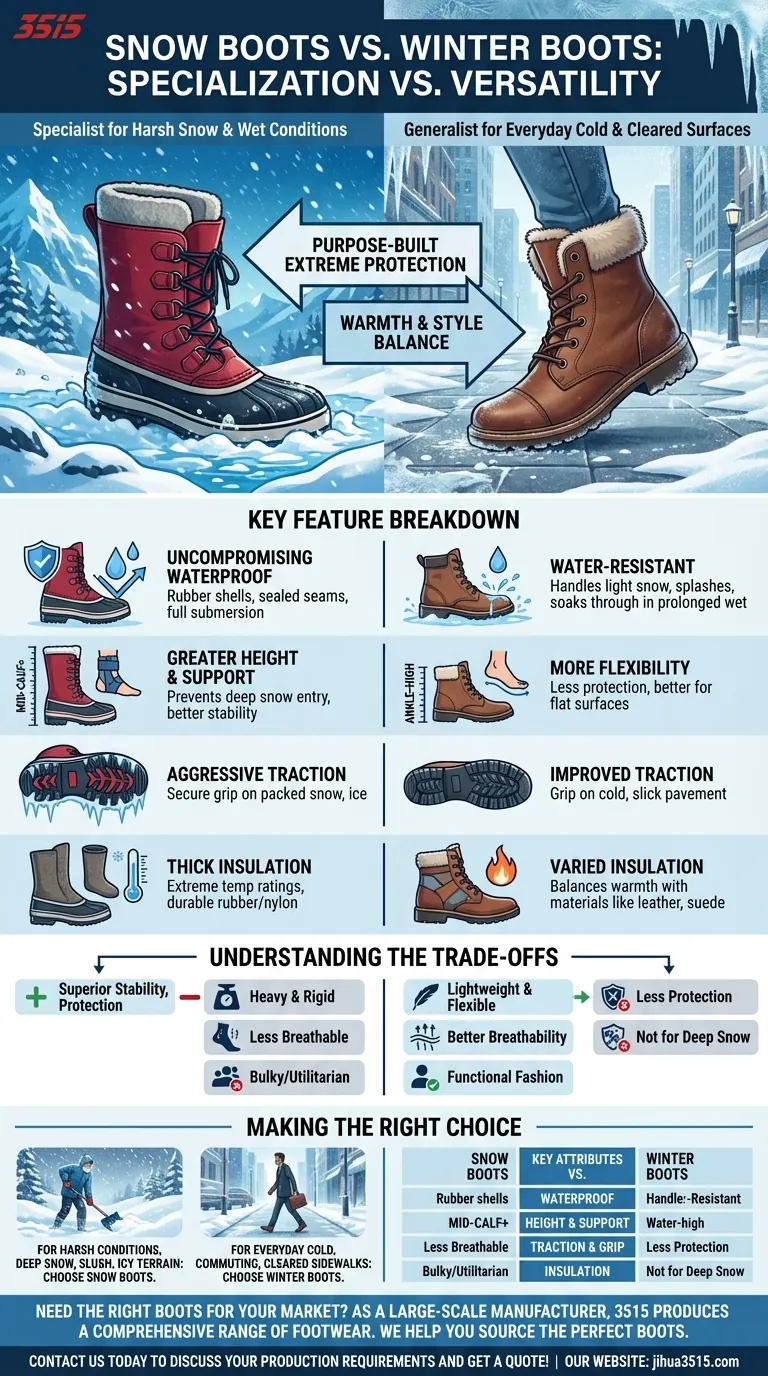The fundamental difference is specialization versus versatility. Snow boots are specialized tools designed for harsh, deep snow and wet conditions, while winter boots are versatile footwear for general cold-weather use on clearer, maintained surfaces.
The choice between a snow boot and a winter boot is not about which is "better," but which is the right tool for the job. Snow boots are purpose-built for extreme protection in the snow, while winter boots balance warmth and style for everyday cold environments.

Specialist vs. Generalist: Defining the Core Purpose
The primary distinction comes down to the environment each boot is designed to handle. One is a piece of specialized gear; the other is an everyday staple.
Snow Boots: Maximum Protection for Harsh Conditions
Snow boots are built for one primary purpose: to keep your feet completely dry, warm, and stable in deep snow, slush, and icy terrain.
Their design prioritizes function over all else. Think of them as essential equipment for activities like shoveling after a blizzard, winter hiking, or navigating unplowed areas.
Winter Boots: Versatility for Everyday Cold
Winter boots are designed for the common challenges of cold weather in more developed environments. They are ideal for commuting, walking on cleared or lightly dusted sidewalks, and running errands.
They provide a necessary upgrade in warmth and traction over regular shoes but are not intended for submersion in deep snow. Their design often blends functionality with everyday style.
Key Feature Breakdown
The difference in purpose leads to significant differences in construction and features.
Waterproofing and Weather Resistance
Snow boots are uncompromisingly waterproof. They typically feature rubber shells and sealed seams designed to be fully submerged in slush and wet snow without leaking.
Winter boots are usually water-resistant. They can handle light snow and splashes from puddles, but their materials may eventually soak through in prolonged, wet conditions.
Height and Support
Snow boots are generally taller, often extending to the mid-calf or higher. This height is crucial for preventing deep snow from getting inside the boot and offers greater ankle support on uneven, icy ground.
Winter boots are typically shorter, often just above the ankle. This provides more flexibility and comfort for walking on flat surfaces but offers less protection from deep snow.
Traction and Grip
The outsoles are a clear point of difference. Snow boots have deep, aggressive lugs designed to bite into packed snow and provide a secure grip on ice.
Winter boots have improved traction compared to standard shoes, but the tread is less aggressive. It's designed for grip on cold, sometimes slick, pavement rather than deep, unstable snow.
Insulation and Materials
Both boot types are insulated, but snow boots often feature thicker insulation or removable felt liners rated for extreme temperatures. Their outer materials are typically rubber and nylon for easy cleaning and durability.
Winter boots use a variety of insulation types and often incorporate materials like leather and suede, balancing warmth with a more refined look.
Understanding the Trade-offs
Choosing one style over the other involves accepting a specific set of compromises.
Weight and Clumsiness
The robust, protective construction of snow boots makes them significantly heavier and more rigid. This is a trade-off for superior stability and protection in harsh weather.
Breathability
The intense waterproofing required for snow boots means they are often less breathable. This can lead to sweaty feet if you wear them for long periods indoors or during high-exertion activities.
Style and Social Appropriateness
Winter boots are designed to be a functional fashion item. They can be worn from the street into an office or restaurant without looking out of place.
Snow boots are purely functional. Their bulky, utilitarian appearance makes them look and feel awkward in most indoor social settings.
Making the Right Choice for Your Environment
Your decision should be dictated by the winter conditions you most frequently encounter.
- If your primary focus is navigating deep snow, slush, and icy, unplowed terrain: Choose specialized snow boots for their non-negotiable waterproofing, taller profile, and aggressive traction.
- If your primary focus is walking on cleared city sidewalks, commuting, and staying warm in general cold weather: A versatile winter boot provides the ideal balance of warmth, comfort, and style for daily use.
Ultimately, matching your footwear to the demands of your environment is the key to staying warm, dry, and safe.
Summary Table:
| Feature | Snow Boots | Winter Boots |
|---|---|---|
| Primary Use | Deep snow, harsh conditions | Everyday cold, cleared surfaces |
| Waterproofing | Fully waterproof | Water-resistant |
| Height | Tall (mid-calf+) | Shorter (ankle-high) |
| Traction | Aggressive, deep lugs | Moderate, for pavement |
| Best For | Shoveling, winter hiking | Commuting, city walking |
Need the Right Boots for Your Market?
As a large-scale manufacturer, 3515 produces a comprehensive range of footwear for distributors, brand owners, and bulk clients. Our production capabilities encompass all types of shoes and boots, from specialized snow boots to versatile winter styles. We can help you source the perfect footwear to meet your customers' specific needs.
Contact us today to discuss your production requirements and get a quote!
Visual Guide

Related Products
- Customizable Slip-On Safety Shoes Direct from the Factory for Wholesale
- Wholesale Customizable Suede Safety Boots - Puncture-Proof with Velcro Closure
- Durable Leather Work Boots for Wholesale & Custom OEM Manufacturing
- Durable Mid-Cut Tactical Boots for Wholesale & Private Label
- Wholesale Durable Mid-Cut Tactical Boots for Custom & Private Label Brands
People Also Ask
- Why is proper fit important in work boots? Ensure Safety, Comfort & Long-Term Health
- What regular maintenance checks should be performed on safety boots? A Daily Safety Checklist
- How does toe box design differ between men's and women's work boots? Fit for a Woman's Foot Anatomy
- What are the potential consequences of wearing improperly designed work boots? Avoid Injury & Boost Safety
- What is the purpose of ASTM International? A Guide to Global Quality Standards



















